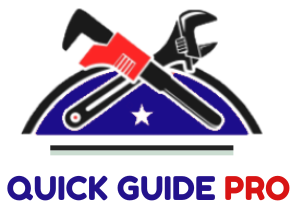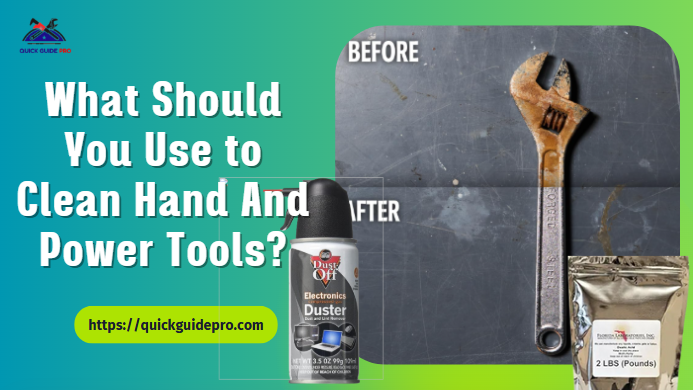
Whether it is a power tool or a hand tool, proper cleaning and care are the keys to performing its best and prolonging its lifespan. But, what should you use to clean hand and power tools and how to clean them safely?
If you are a licensed contractor or a DIY handyman, you probably know how easy it is for the tools to become greasy, dirty, oily, or even rusty and corroded.
However, with the right cleaning agents and a little extra effort, you can always keep them in good conditions to function correctly.
Before using a cleaning agent, make sure it is safe to use or won’t damage your tool.
I’ve put together this guide to help you know what works best for power and hand tool cleaning.
Table of Contents
What Should You Use to Clean Hand and Power Tools?
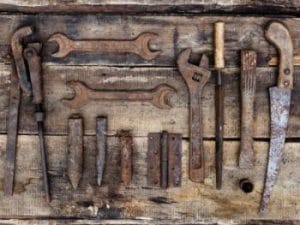
You won’t need many items or materials to clean your hands and power tools.
In most cases, all that you may need to clean your tools are a few simple hand-cleaning items, some elbow grease, and some compressed air.
When cleaning old tools, you will likely come into contact with rusted spots. However, you can clean light to moderate rusted tools with several inexpensive home supplies. To remove the stubborn rust, you may need to use a chemical solution.
Let’s find what you should use to clean hand and power tools.
To Remove Dust/ Soil:
• Rag (dry/ dampen)
• Shop vacuum
• Can of compressed air
• Detergent
Almost all types of tools accumulate dust and dirt. Even power tools with a pro-grade dust-collecting system may still build up dust and grime.
What should you use to clean hand tools?
After finishing your task, wipe off all the visible and gross soil and debris from your hand tools. Use a clean rag to do this. To clean stubborn dirt or soils, sometimes you may need to rinse your hand tool.
Rinse all the surface area of your tool until it is visibly free of soil. You give it a good wash with the right detergent. Once done, rinse it thoroughly and make sure you dry it immediately.
What should you use to clean power tools?
Power tools feature complex electrical and mechanical parts. Therefore, it is more important to keep them well-maintained and clean. Power tools such as power ratchet, nailers, sanders, wood routers, drills, and saws all need to be properly cared for keeping them in good working condition for a long time.
Wipe the build-up of dust and debris down with an old towel or clean rag after finishing a job. For a deep clean, use a damp rag or cloth to remove the dust and grime from the exterior. If your tool has any PVC or molded plastic parts, with a dry rag, gently wipe them off.
To clean the hard-to-reach parts of your power tool, use oiled cotton swabs. You can also use a shop vacuum to suck out dust as much as possible. A can of compressed air is also convenient to blow out the dust deep in the air vents.
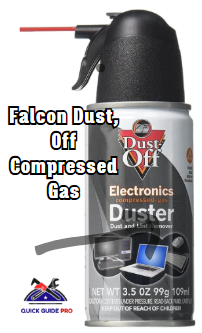
While removing dust, take special care of filters if your power tool includes any. Vacuum the filters thoroughly.
To Remove Light-to-Moderate Rust- Natural Solutions
If the metal components of your tool have light-to-moderate rust, scrubbing is an excellent first step.
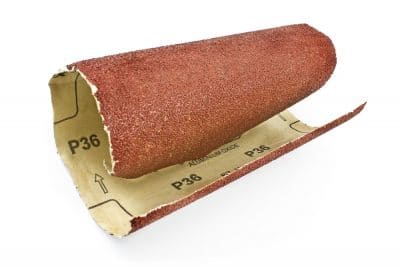
You can remove these by scrubbing with appropriate abrasive materials. There are several options. Some of which are:
• Sandpaper
• Scouring pads
• Wire brush/ stiff brush
• Steel wool
• Drill-powered wire wheel (for a tough job)
In some situations, only scrubbing might not be enough. If your tool is a bit corroded but not super rusty, natural solutions offer an effective and inexpensive way to remove the surface rust.
Natural Solutions:
The following are some of the available natural formulas that you can use for rust removal from your tools.
- Vinegar: The cheapest way to clean your tool is with white vinegar. Conveniently, you can use vinegar straight from the bottle. It also works great for removing rust. The mixture of white vinegar and salt softens the rust spots and makes it easier to scrub the rust off the surface.
- Lemons and salt: These two items work as a killer rust remover. It is also an affordable option like vinegar, but you have to follow more steps to apply these items than vinegar. What you have to do is- first, coat your tools with salt. Then, squeeze lemon juice over the surface of your tool. Leave it for several hours so that the tool can soak the lemon and salt mixture.
- Baking Soda: To remove the rust from smaller spots of your tool, it is an excellent option. Make a paste by mixing baking soda with water. Then, smear the paste all over the surface of your tool. Leave it for a couple of hours to allow it to soak. Once the paste sets, scrub it with a brush until the rusts come off.
To Remove Heavy Rust
Chemical Formula
If your tools are badly rusted, natural solutions will not work effectively. In this case, you’ll need something more effective- a chemical formula.
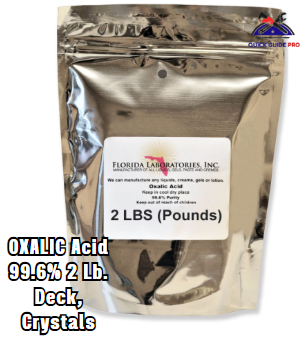
It’s a commercial rust remover that dissolves tough-to-remove rust. Mix three tablespoons of oxalic acid with one gallon of water. Soak your rusty hand tool in this mixture and leave it for 20 minutes. Then, simply rinse away the rust and all the acid. Dry your tool off. You should read the product instructions first.
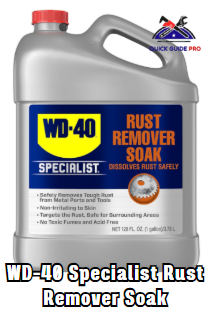
This formula is great for removing as well as preventing rust. To remove badly affected rust, standard WD-40 won’t be enough to use. Instead, WD-40 specialist rust remover is best to use. This one comes in a larger volume pack, so you can easily soak your rusted tool. No worry, this solution is biodegradable and non-toxic.
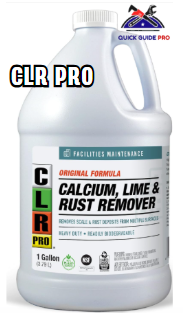
This formula is great for de-rusting your hands and power tools. It offers industrial-strength performance to remove rust, lime, and calcium. In addition, you can use it to remove the hard water stains from your showerhead. This solution is septic-safe and EPA certified.
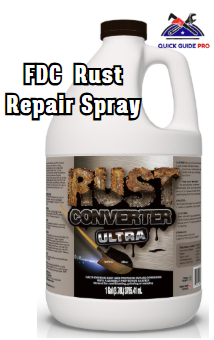
This formula is very effective in transforming rust into an inert coating. It also seals out moisture to prevent further rusting and corrosion. Although FDC is expensive, a one-gallon pack can de-rust a maximum of 500 sq. ft. That means you can de-rust a lot of tools with this formula.
- Elbow Grease– Lubricant
Regardless of which natural or chemical solution you need to employ, you’ll need to apply some elbow grease to your tool after removing the rust. Elbow grease is formulated to lubricate your tools in all situations, including machinery and engines.
- Corrosion Protector/ Rust Inhibitor
Once successfully removed the rust and thoroughly cleaned your tool, you may need to spray corrosion protectors to prevent further rusting like Boeshield T9 or WD 40. T-9 is a great choice that works as both a lubricant and a protectant.
Proper lubrication works effectively to prevent degradation of metal parts, which otherwise may lead to other parts wearing out prematurely.
What Should You Use to Clean Hand and Power Tools- Related FAQs
The following section will help you find out more about a tool cleaning products.
Is WD-40 a rust remover or cleaner?
WD-40 removes rust. It cuts through and dissolves the rust, restoring the surface to bare metal. It is not only used for removing rust, but it is also considered a cleaning product that can be used in this capacity as well.
How fast does vinegar remove rust?
If the object is too large, dab or spray vinegar over the rusted area. Allow the vinegar to soak in for at least 30 minutes. If you’re dealing with a lot of rust, a long soak will probably be necessary.
What is proper for the care of hand tools?
Dust and debris buildup can cause your hand tool damaged over time. So, keep your hand tools always clean, free of all dust and debris. If your tool is very dirty, don’t hesitate to give it a good wash with soap and warm water. However, don’t forget to dry them properly soon after. Sprinkle WD-40 on the metal parts of your tool and wipe with a dry, clean rag. There you have it!
What should I put on my tools to prevent rust?
Apply rust inhibitors to add protective coatings on the metal surface of your tool. If your tool is susceptible to rust, keep a moisture-absorbing gel pack in your toolbox or drawer. This silica-gel desiccant absorbs excess moisture from the air and decreases humidity levels in the enclosed areas. Vapor-corrosion inhibitor (VCI) is a viable option to achieve the same result.
How to use WD-40 to clean tools?
First, wipe off any dirt or grease with a rag. Spray WD-40 on your tool to add a light coating. Allow the coating to sit for a few seconds. Before the coating dries on its own, wipe your tool off with a clean rag. Once done, put your tool back where it belongs.
How to clean a drill?
By using a shop vacuum, suck up your electric drill. Then clean out the vents by blowing out compressed air. Spray around all the moving parts of your drill: arbors, blades, drill chucks, etc. Clean off the PVC or molded plastic components by using a damp, clean rag.
How to lubricate an electric drill?
Disassemble both bearings of your electric drill. Apply lightweight machine oil to both bearings. Once done, fit the front and rear bearings onto the front and rear of the armature shaft. Reassemble your drill.
Should you grease a powered ratchet?
If your powered ratchet (corded or cordless) receives daily workouts, you should grease its ratching mechanism regularly. You should adjust the lubrication schedule according to the usage. Check your owner’s instruction manual to see if the tool requires any specific type of lubricant.
So, What Is the Best Thing to Clean Tools With?- My Parting Shots….
Now that you know what you should use to clean hand and power tools, it’s time to better maintain and prevent rust on tools.
To keep your tools in good condition, follow the best practices to clean and store them properly.

I’m Ivan D. Mitchell. I’m the Chief Engineer, Manufacturing Engineering Tool and Launch, specialising in automotive equipment design and build which meets World Class Manufacturing methodology. I have 15 years of work experience as a Tooling Specialist on some of the leading automotive manufacturing companies. When I launched this site, I wanted to create a platform where you’ll get everything about tools in one place. I also wanted to share my experience in the tool industry. I’ll do my best to share the information you need to truly make your tool using experience better. I hope you find our guides, reviews, information HELPFUL. If you have any inquiries, I’m always here to help you.
